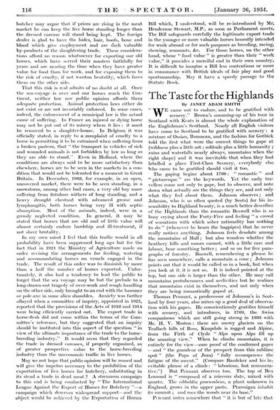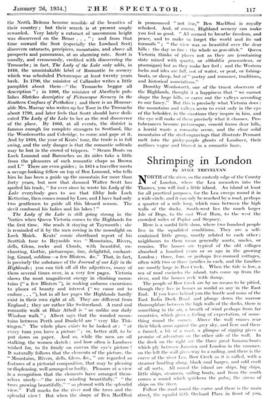The Taste for the Highlands By JANET ADAM SMITH "
WE came out to endure, and to be gratified with scenery." Brown's summing-up of his tour in Scotland with Keats is almost the whole explanation of the Englishman's Scotland. Nearly all English visitors have come to Scotland to be gratified with scenery : mixture of Ossian, Rousseau, and the fashion for Gothick told the first what were the correct things to gape at (wildness plus a little art ; solitude plus a little humanity ruins- and waterfalls nearly always, mountains- when the right shape) and it was inevitable that when they had labelled a place First-Class Scenery, everybody else ivho came to be gratified should visit it too.
The gaping begins about 1760 : '" romantic " and " picturesque " are the keywords-. Yet the early tra= vellerg come not only to gape, -but to observe, and note down what actually arc the things they see, and not only what they feel about them. Johnson observes ; and Johnson, who is so often quoted (by Scots) for his in- sensibility to Highland beauty, is a much better describer of the Highlands than the romantic Boswell who is so busy crying about the Forty-Five and feeling " a crowd of sensations with which sober rationality has nothing to do" (whenever he hears the bagpipes) that he never really notices anything. Johnson feels desolate among the mountains of Mull ; but also wonders whether the heathery hills and moors cannot, with a little care and labour, bear something better ; and so on for five para, graphs of forestry. Boswell, remembering a phrase he has seen somewhere, calls a mountain a cone ; Johnson points out that it would be called so in a book, but when you look -at it, it is not so. It is indeed pointed at the top, but one side is larger than the other. lie may call mountains protuberances and acclivities but he realizes that mountains exist in themselves, and not only when they are being romantically gaped at.
Thomas Pennant, a predecessor of Johnson's in Scot- land by-four years, also mixes up a. good deal of observes- tion- with his gapes; He conscientiously gratifies himself with scenery, and introduces, in 1769, the Swiss comparisons which are still going strong in 1933 with Mr.- H. V. Morton : there arc snowy glaciers on Teallach hills of Ross, Knapdale is rugged and Alpine, from the Firth of Clyde " Alps upon Alps fill up the amazing view." When he climbs mountains, it is entirely for the view—sure proof of the confirmed gaper —and " the grandeur of the prospect from this sublime spot " (the Paps- of Jura) " fully recompenseS the fatigue of the ascent." r(Compare Baedeker and hiS in: evitable phrase of a climb : " laborious, but. remunera- tive.") But Pennant observes too. The top of Beti. Lomond is " composed of a miceous slate, mixed with quartz. The sibbaldia procumbens, a plant unknown in England, grows in the upper parts. Ptarmigan inhabit its summit and roes the woods near its base." - Pennant notes somewhere that " it is but of late that the North, Britons became sensible. of the beauties of their country ; but their search-is at-present amply rewarded.. Very lately a cataract of _uncommon height was discovered on the Bruer . . " ; and from that time-onward the Scot (especially the -Lowland . Scot) discovers cataractsi.precipices, mountains, and above all prospects and panoramas, at an alarming rate.. Scott is usually, and erroneously, credited with discovering the Trossachs ; in fact, The Lady of the Lake only adds, in 1810, the unmistakable label of Romantic to scenery which was scheduled Picturesque at least twenty years back In 1790, the minister of Callander writes a little pamphlet about . them—" the Trossachs - beggar all description " ; in 1806, the minister of Aberfoyle pub- lishes Sketches :descriptive of Picturesque Scenery in the Southern Confines of Perthshire ; and there is-an Honour- able Mrs. Murray who writes up her Tour in the Trossachs about 1799, and later feels that. Scott should have dedi- cated The Lady of the Lake to her as the real discoverer of the place. By 18Q3, at all events, the district is famous enough for complete strangers to Scotland, like the Wordsworths and Coleridge, to come, and gape at it. And;by 1818, the year of Keats' tour, the trade is in full swing, and the only danger is that the romantic solitude may be lost in the crowd of trippers. " Steam Boats on Loch Lomond and Barouches on its sides take a little from the pleasures of such romantic chaps as Brown and I. There are even guides ; in 1814 a traveller meets a savage-looking fellow on top of Ben Lomond, who tells him he has been a guide up the mountain for more than forty years, but now that damned Walter Scott has spoiled his trade, " for ever since he wrote his Lady of the Lake everybody goes to see that filthy hole Loch Ketterine, then comes round by Luss, and I have had only two gentlemen to guide all this blessed season. The devil confound his ladies and his lakes !
The Lady of the Lake is still going strong in the 'forties when Queen Victoria comes to the Highlands for the first time. She reads it staying at Taymouth ; she is reminded of it by the men rowing in the moonlight on Loch Muick. Keats' comic shorthand report of his Scottish tour to Reynolds was " Mountains, Rivers, dells, Glens, rocks and Clouds, with beautiful, en- chanting, Gothic, picturesque, fine, delightful, enchant- ing, Grand, sublime—a few Blisters, &c." That, in fact, is precisely the substance of the Journal of our Life in the Highlands ; you can tick off all the adjectives, many of them several times over, in a very few pages. Victoria shows the most magnificent energy in climbing moun- tains (" a few Blisters "), in making arduous excursions to places of beauty and interest (" we came out to endure .. . "), but in all her pages the Highlands hardly exist in their own right at all. They.are different from England ; they are rather like Switzerland. A rural and romantic walk at Blair Atholl is " so unlike our daily Windsor walk " ; Albert says that the wooded moun- tains between. Perth and Dunkeld are " very like Thu- gingen." The whole place exists to be looked at ; " at every turn you. have a picture " ; or, better still, to be put down on paper. And so, while the men are off stalking, the women sketch ; and how often is Landseer wished for, to fix firmly on canvas the eye's picture ! It naturally follows that the elements of the picture, the " Mountains, Rivers, dells, Glens, &c., " are regarded as features of a pictorial composition, that may be pleasing or displeasing, well arranged or badly. Pleasure at a view is a recognition that the elements have arranged them- selves • nicely—" the river winding beautifully," " the trees growing beautifully," " so pleased with the splendid View." Full marks for the river and the trees and the splendid -view! But when the shape of Ben MacDhui is pronounced " not fine," Ben MacDhui is royally rebuked. And, of course, - Highland scenery can make you feel so good. " All seemed to breathe freedom, and peace, and to make us forget the work! and its sad turmoils " ; " the view was so beautiful over the dear hills : the day so fine : the whole so gemfillich." Queen Victoria thinks of places not as they arc (containing slate mixed with quartz, or sibbaldia procumbens, or ptarmigan) but as they make her feel ; and the Western lochs and isles are full, not of water, or peat, or fishing- boats, or sheep, but- of " poetry and romance, traditions, and historical associations."
Dorothy Wordsworth, one of the truest observers of the Highlands, thought it a happiness that " we cannot shape the huge hills, or carve out the valleys according to our fancy." But this is precisely what Victoria does the mountains and valleys seem to exist only in the eye of the beholder, in the emotions they-inspire in him, and the eye will make of them precisely what it chooses. Pro- tuberances become picturesque, conoid forms dear hills, a horrid waste a romantic, scene, and the clear solid Mountains of the steel-engravings that illustrate Pennant melt into the pinky-purple ghosts of Landseer, their Outlines vague and blurred in a romantic haze.











































 Previous page
Previous page